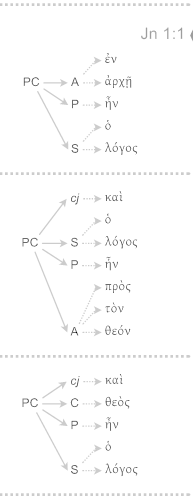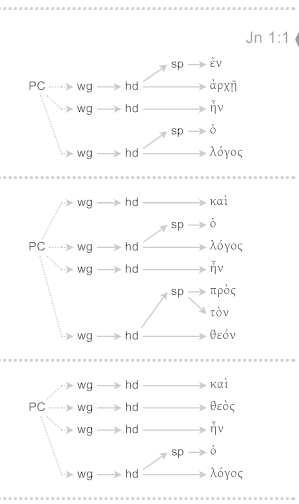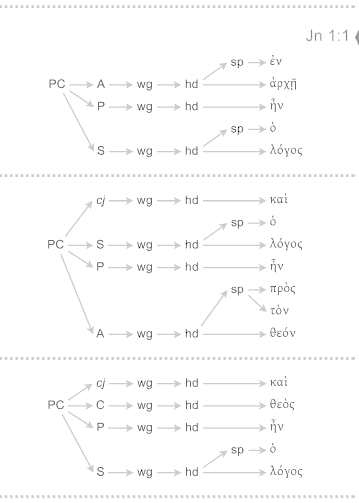I’ve blogged about the OpenText.org Syntactically Annotated Greek New Testament in the past (see the Syntax Archives).
The folks who do the work on the OpenText.org project have been doing a lot of work since I last blogged about the project, and the result is that we have a vastly updated data set. The primary new goodie is the consolidation of the Clause and Word Group information.
When I previously discussed the OpenText.org material, I blogged about a Clause visualisation and about a Word Group visualisation. Well, there is no longer a distinction; the two have become one. The syntax graphs now mix the hierarchy so you can follow both levels in a single graph. For example, below is the graph for John 1.1:
The verse consists of three Primary clauses. The first primary clause consists of an Adjunct (?? ???? or “in the beginning”), a Predicator (?? or “was”) and a Subject (? ?????, “the Word”). Further, we know that the adjunct consists of a word group that consists of a specifier (which is an article or (as in this case) a preposition) and the head term that is modified by the preposition, hence “in the beginning”. We also see that the subject is a word group that consists of a specifier (here an article) and the head term it modifies, thus “the word”.
These integrated levels are all customisable. So if I only want to view the clause and clause component stuff, I can:

The dotted lines indicate where structure (in this case, word group materal) has been collapsed. Or if I only want to view the Word Group stuff, I can:

So, this is pretty cool now with the levels integrated; you can get a better idea of what is going on in the text at both the word group and the clause levels. You can also isolate levels to view trends at a particular level.
Integrating these two levels offers some interesting customisability that allows you to tailor the graphs to the desired view and to examine the sorts of things you want to examine. You’d be amazed at what you stumble upon in scrolling through the text and visually recognising similar graph structures in close proximity.
More on that last bit in a later post.





